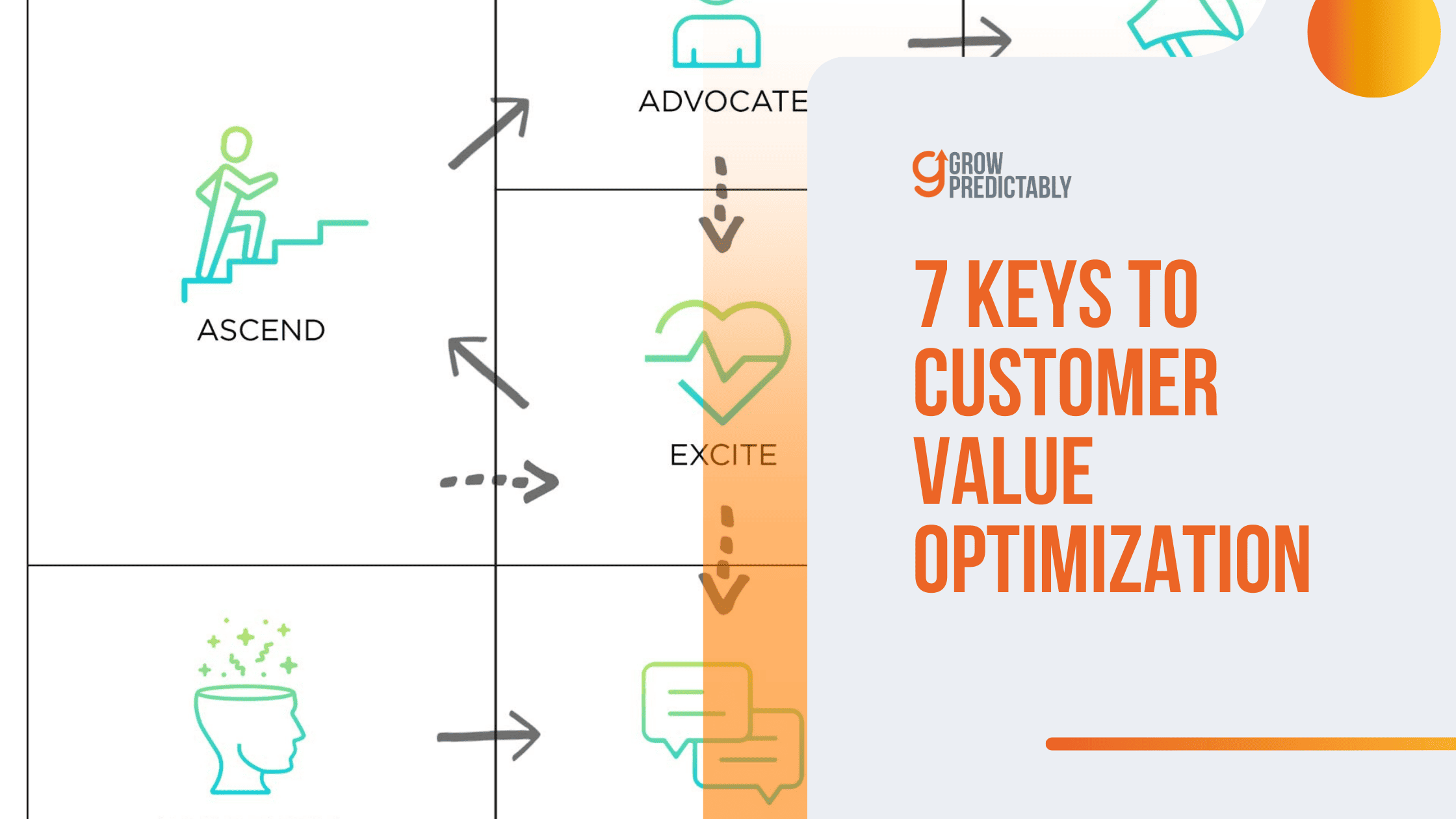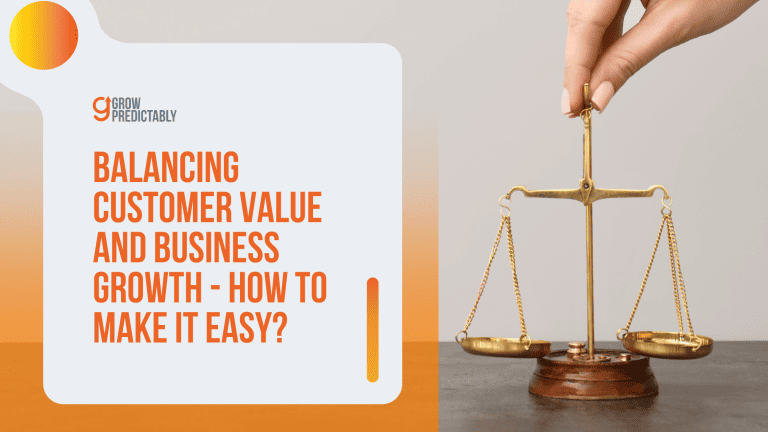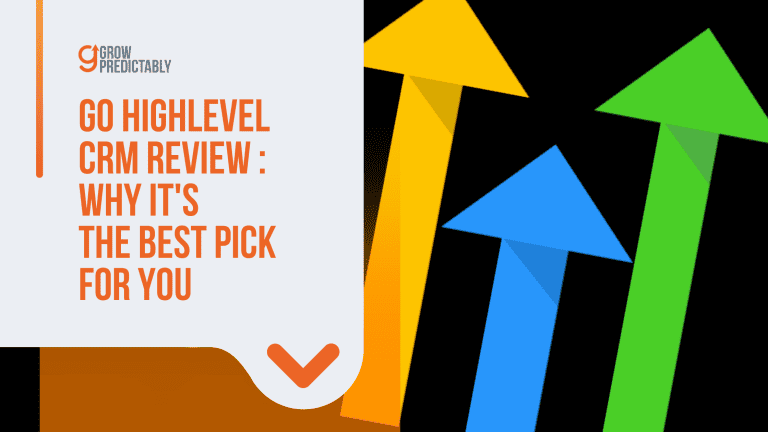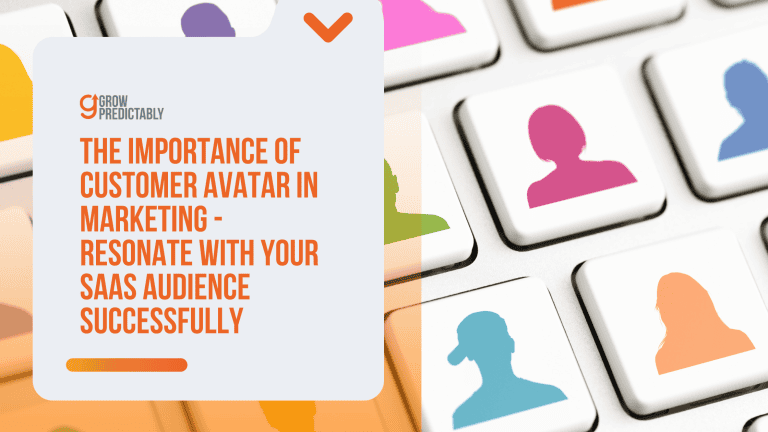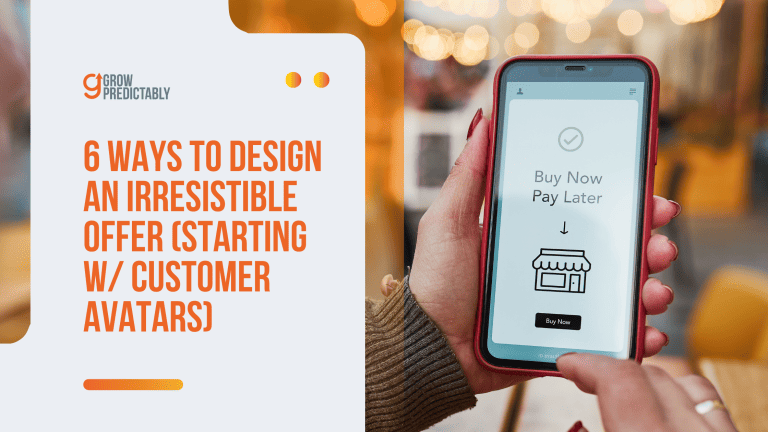7 Keys To Customer Value Optimization in 2023
Can you believe that a whopping 96% of customers rank customer service as the top factor influencing brand loyalty? This eye-opening statistic, among others, highlights the undeniable role customer service plays in a business’s success.
Yet, despite its significance, customer value often finds itself isolated from the core of the company, perceived as a necessary burden rather than a game-changing asset.
This is a mistake!
You see, it’s not just about swiftly addressing a customer’s concern. Stellar customer service involves cultivating lasting relationships with your customers, ensuring they keep coming back for more.
One of the most effective ways to achieve this is by embracing customer value optimization (CVO). This transformative process enables businesses to boost revenue by understanding and maximizing their customers’ lifetime value.
Armed with the right approach, customer value optimization can become a potent tool for fueling growth and fostering loyalty. In fact, businesses that excel in customer service are an astounding 85% more profitable than their counterparts! (Forrester Study)
Ready to unlock the full potential of customer value optimization? This all-encompassing guide will reveal everything you need to know. We’ll kick off by outlining the objectives and then guide you through each step.
By the time you reach the end of this guide, you’ll be equipped with all the knowledge required to start unlocking greater value for your business. So, let’s dive in and revolutionize your customer relationships!
The Objective of CVO
CVO aims to enhance customer lifetime value (LTV) through the optimization of customer acquisition, engagement, and retention rates along the eight different stages of the customer value journey.
This is achieved by comprehending the customer journey, spanning from awareness to purchase and post-purchase, and identifying the crucial touchpoints impacting a customer’s decision-making process.
Promptly influencing a customer’s decision-making process is essential for every business.
The process begins with gaining insights into your current customers.
“You can’t transform something you don’t understand. If you don’t know and understand what the current state of the customer experience is, how can you possibly design the desired future state?”
Annette Franz
After grasping the customer journey, CVO takes advantage of data and analytics to recognize the optimization opportunities that will significantly affect LTV.
These identified opportunities are subsequently assessed and put into action via marketing campaigns, website design alterations, or shifts in product/pricing plans.
How To Calculate Your Customer Value?
Customer value represents the perceived significance of a product or service, which keeps customers returning. The “X-factor” sets your business apart from competitors, making it distinct and unique.
There are multiple methods to determine customer value, but ultimately, it can be simplified to this formula:
Customer Value = Benefits / Costs
In essence, it is the total sum of all benefits customers receive from utilizing your product or service, divided by the costs (both monetary and opportunity costs).
- Benefits may range from experiencing happiness and satisfaction with the purchase to obtaining the total value of the product or service.
- Conversely, costs could include factors such as the product’s price or average transaction value, the time required for usage, and any negative emotions associated with its use.
It is crucial to remember that customer value is highly subjective – what one individual perceives as a valuable benefit might not hold the same value for another.
This is why understanding your target audience and their preferences for a product or service is vital before attempting any calculations.
What Are The Steps to Customer Value Optimization?

The customer value optimization (CVO) process is clear-cut and straightforward to follow. We will delve into each step in this section.
1. Determine Product/Market Fit
The foundational step for effective customer value optimization is confirming that your product addresses people’s wants or needs. While it may seem apparent, it’s astounding how many businesses fail to recognize this.
Before committing extensive time or resources, allocate some effort to validate your idea with potential customers.
It’s crucial to verify that there is market demand for your product.
Do some research and find out if people are interested in what you have to offer. If not, you may need to tweak your product or target a different market.
Some factors that you need to consider include:
- Whether people understand what your product does
- Whether people are willing to pay for your product
- How much competition is already in the market
Don’t forget, the world keeps changing, and so does product/market fit. That fantastic idea you had five years ago? It might not hold the same relevance today.
Now, imagine you’ve found a market hungry for your product. What’s next? It’s time to craft a compelling value proposition. Speak to your customers’ hearts by highlighting how your product benefits them and solves their problems.
Ask yourself: What sets your product apart? Why would someone choose it over others? Which pain points does it alleviate?
Consider how your product simplifies their lives. Can you see the relief on their faces?
Your value proposition should be clear, straight to the point, and quickly grasped. Speak their language, connect with them, and watch your idea thrive.
2. Choose a Traffic Source
So, you’ve nailed your product/market fit. What’s next on the journey? It’s time to shift gears and focus on customer acquisition.
After all, customers are the beating heart of every customer value optimization. And let’s face it – without customers, there’s no business.
Now, think about the numerous ways to generate traffic. How do you pick the one that resonates with your company’s essence?
You could explore paid advertising, dip your toes into search engine optimization (SEO), embrace social media marketing, or even rely on the power of word-of-mouth marketing.
But remember, the key is to start, experiment, and keep testing different methods. So, take that leap of faith, and soon enough, you’ll discover what works best for you and your unique brand.
· Paid Advertising
Craving instant results? Paid advertising might just be your go-to. Platforms like Google AdWords and Facebook Ads let you target potential customers with ads tailored to their interests.
But it’s not all sunshine and rainbows – paid advertising can be costly, and you’ll need to closely watch your campaigns to ensure a positive ROI.
· Search Engine Optimization (SEO)
Patience is the name of the game with SEO. It’s a long-term strategy that could take months or even years to bear fruit. However, it’s among the most effective ways to generate organic traffic. By optimizing your website for search engines, you’ll boost visibility and attract visitors over time.
The secret to SEO success? Crafting high-quality content that speaks to your target audience.
· Social Media Marketing
Social media marketing offers another fantastic avenue to connect with potential customers. Platforms like Facebook, Twitter, and Instagram empower you to build relationships with your target audience while sharing content they’ll love.
To triumph in social media marketing, maintain consistency and create captivating, engaging content.
· Word-of-Mouth Marketing
Sometimes, the classics are unbeatable. Word-of-mouth marketing, one of the oldest and most effective forms of promotion, relies on satisfied customers sharing their experiences with friends and family.
This helps you draw in new customers without spending a dime on advertising.
So, how do you spark word-of-mouth marketing? Deliver an extraordinary experience that leaves your customers over the moon. And watch the magic happen.
Again, there are a few to consider when choosing a traffic source:
- Paid Advertising
- Search Engine Optimization (SEO)
- Social Media Marketing
- Word-of-mouth Marketing
3. Offer a Lead Magnet
More often than not, you’ll want to offer a lead magnet. What’s that, you ask? It’s an irresistible freebie that lures people into signing up for your email list. Be it a PDF report, an e-book, a coupon, or other valuable offering.
The secret sauce? Making sure your lead magnet is closely tied to the product or service you’re selling. That way, you’ll draw in folks genuinely interested in what you’re all about.
Got your lead magnet ready? Time to spread the word. Dive into paid advertising, social media, guest blogging, or any other traffic source that feels right for you.
Remember, attracting people to your lead magnet is crucial for building relationships. Once you’ve connected, you can introduce them to products and services they’ll be eager to buy.
4. Offer An Entry Point Offer (Tripwire)
Picture this: an entry point offer, sometimes known as a tripwire. It’s a low-priced (but definitely not low-value) product or service that entices people to buy from you.
Its purpose? To welcome customers with open arms and foster meaningful relationships.
Once they’ve experienced their first delightful purchase, why not gently guide them toward your more upscale products or services?
5. Offer a Core Product
So you’ve found your product fit and selected a traffic source – what’s next on the agenda? It’s time to turn your attention toward generating revenue, and for that, you need to create a core product.
Now, what should this core product look like? It needs to be something that speaks to your target market’s desires or necessities – something they’ll happily pay for. And, naturally, it should be an item you can sell at a profit.
To determine your core product, there are two (2) basic approaches that you can use.
- Look at your competition and see their offerings.
- Survey your target market and ask them what they would be interested in purchasing.
Once you’ve figured out your core product, it’s time to bring it to life. This could mean anything from developing a brand-new product to giving an existing one a new packaging makeover.
With your core product ready to shine, it’s time to start selling! Various channels are at your disposal – online storefronts, brick-and-mortar stores, or even direct sales.
No matter what channel you choose, ensure that your core product promotion reaches your target market. And remember, you can always explore different channels and strategies to discover the perfect fit for your business.
6. Offer a Profit Maximizer
Once you’ve generated revenue with your core product, it’s natural to start pondering profits. How can you boost them? One approach is to introduce profit maximization.
A profit maximizer is any product or service you provide to customers with an attractive profit margin. It could range from digital offerings to physical goods. The trick is to identify something your target market will happily pay for that you can sell at a substantial margin.
The challenge? Finding a channel that suits you while effectively reaching your target audience. And always remember, you can experiment with diverse channels and strategies until you discover the ideal combination for your business.
7. Create the Return Path
Imagine a way to keep customers coming back for more – that’s where the return path comes in. It’s the process you create to ensure customers return to your business. This might include tactics like email marketing, customer loyalty programs, or referral incentives.
By crafting a return path, you’re not only amplifying customer lifetime value but also enhancing your bottom line and fostering business growth.
Simply follow these easy-to-implement steps, and you’ll maximize the value your customers derive from your business. As a result, you’ll see your profits grow and develop a faithful customer base.
The Customer Value Journey – The Ideal Sales Funnel

In our quest to help you optimize customer value, we’ve crafted an easy-to-follow guide just for you. By embracing this flow, you’ll be able to boost revenue as customer value optimization becomes the core of your business.
Here are the seven steps of the customer value journey and what they mean:
1. Awareness

The first step is to make your target market aware of your business and all that you have to offer. How can you achieve this? Explore various marketing channels like SEO, paid advertising, and social media.
2. Engagement

Once you’ve captured your target market’s attention, it’s the perfect time to engage with them.
How? Provide them with valuable content that answers their burning questions and shows them they’ve arrived at the right place.
Engagement is all about sparking a conversation with your audience. The key to this lies in crafting content that’s not only intriguing but also relevant to their needs.
When you get them talking, you’re well on your way to forging a robust relationship with your target market.
You can create captivating blog posts, videos, quizzes, or other content that speaks to your audience.
3. Subscribe

After you’ve engaged with your target market and built a relationship with them, it’s time to get them to subscribe to your email list or loyalty program.
This will help you keep them updated on your latest offerings and bring them back to your business again and again.
4. Convert
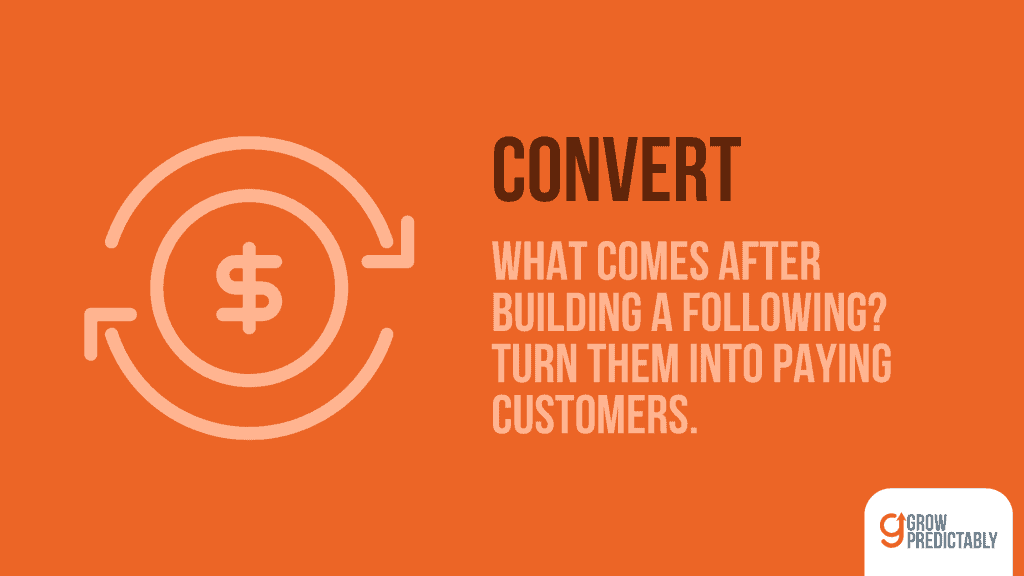
Having built a database of potential customers through your email list or loyalty program, what’s the next move? It’s time to turn them into paying customers!
This process, called lead generation, offers a variety of strategies to help you achieve this goal.
One common method is to give a free trial of your product or service. This allows potential customers to experience the value you provide before making any commitment.
Another popular approach is to offer a discount on your services. This can be a powerful way to attract price-sensitive customers who are still on the fence about your product.
Whichever approach you choose, remember that your goal at this stage isn’t to sell your most expensive product. Instead, concentrate on delivering value and building trust with your new audience.
Once you’ve established a relationship, you’ll be in a prime position to secure a larger sale down the road.
5. Excite

Once you’ve converted your customer, you need to wow and excite them. They should experience that “aha!” moment where they truly see the value in what you’re offering.
How can you create this moment? One approach is to surprise them with an unexpected discount or free gift alongside their purchase. This demonstrates your generosity and desire for them to be delighted with their decision.
Another way to spark a wow moment is by enabling them to achieve a small success using your product or service. This reassures them that your product delivers on its promises and opens their eyes to its potential.
Whatever you choose, ensure it’s something that captures their attention. A touch of excitement can significantly boost the lifetime value of a customer.
6. Ascend

When we effectively implement the ‘excite’ component (stage 5), the initial conversion allows our new buyer to attain a minor victory. They are now able to perceive the enormous potential before them and naturally desire more (without resorting to forceful selling techniques).
Additionally, they are considerably more apt to accept our future offers, which is vital for a long-lasting, prosperous relationship. In summary, it is beneficial to arouse enthusiasm in our prospects and present them with a simple conversion method.
This underpins a robust sales funnel that will consistently yield results in the years to come.
With customer acquisition costs on the rise, optimizing each client’s lifetime value has become increasingly crucial.
This not only assists in counterbalancing the expenses of acquisition but also sets the stage for the subsequent phase of the customer lifecycle: advocacy.
7. Advocate
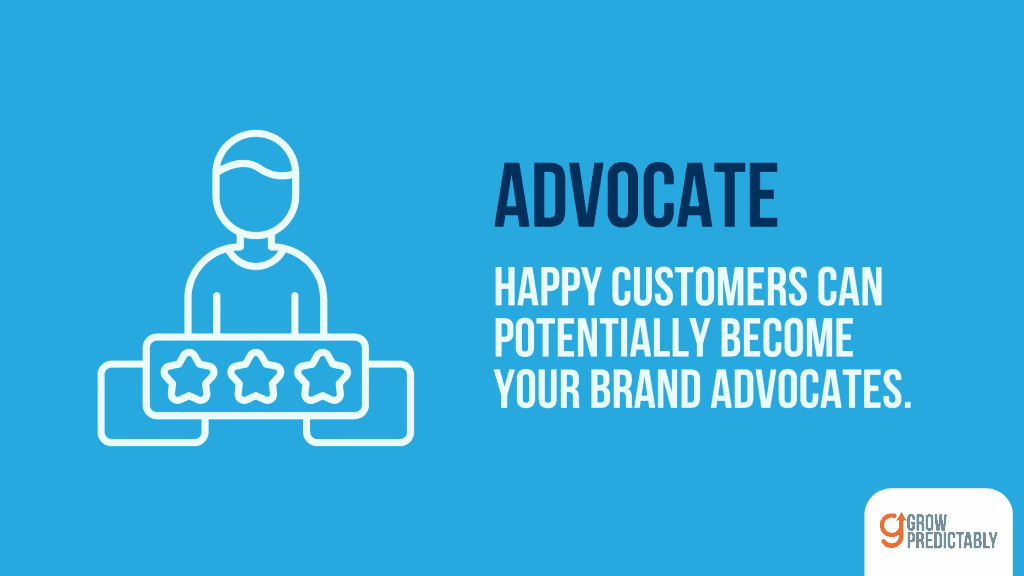
By providing exceptional customer experiences and honoring your commitments, you foster advocates ready to promote your business.
As it’s commonly understood, word-of-mouth remains the most potent marketing instrument at hand.
Therefore, if your objective is to reduce acquisition costs and increase your customer base, prioritize turning your present clients into advocates. This method is the optimal way to maintain your business’s momentum.
8. Promote

When we’ve executed our strategies flawlessly, we foster advocates and unlock the potential to establish a sales force.
People who are passionate about something share their excitement with friends. They’ll laud it on social media, author reviews, and blog posts and generally employ every possible avenue to disseminate the news.
This is precisely our objective. As conversations about our product or service gain momentum, sales naturally follow.
By encouraging our advocates to put in some effort on our behalf, we inch closer to accomplishing our goals. You might even consider initiating an official revenue-sharing program.
Understanding the customer value journey is essential for any business that wants to create long-term customers and increase sales.
It is the process that customers go through when they become aware of a problem or need, consider solutions, make a purchase, and continue buying your products or services.
By understanding this journey (sales funnel), businesses can ensure that they are providing the right solutions at the right time and creating an overall positive experience that will keep customers coming back.
Additionally, by tracking metrics such as conversion rates and customer satisfaction levels at each stage of the journey, businesses can identify areas where they need to improve in order to further increase sales and create even more loyal customers.
Other Tips To Follow
Some more tips to follow if you want to optimize your customer’s value include:
- Use the Right Advertisements: You should ensure that your ads are relevant to your target audience and offer value. Otherwise, you’re just wasting your time and money.
- Offer Additional Value: In addition to the product or service you’re selling, consider offering additional value such as free shipping, a loyalty program, or referral discounts.
- Sound Like a Human: When communicating with customers, sound like a human being instead of a robot. This will make them feel more valued and appreciated.
- Share Product Reviews: Share reviews from happy customers on your website or social media pages. This will show potential customers that customer satisfaction is a priority for you.
- Offer Live Chat Assistance: Make it easy for customers to get in touch with you by offering live chat assistance. This way, they can get their questions answered quickly and efficiently.
By following these tips, you can ensure that you are providing your valuable customers with the best possible experience and value for their money. Implementing a customer value optimization strategy is essential to any business’s success.
FAQs
People have sorts of questions when it comes to customer value optimization (CVO) and we’ve compiled three of the most common questions down below to answer them one by one.
In Summary
Imagine truly understanding the deepest desires and needs of your target audience. Picture crafting a strategy that speaks directly to them, delivering the perfect message at the right moment. That’s the power of customer value optimization.
You might wonder, “Can this be a game-changer for my business?” The answer is a resounding yes – but only if done correctly.
Why not take your business to new heights and make that personal connection with your customers? It’s time to start implementing a customer value optimization strategy today. Trust me; you won’t regret it.

